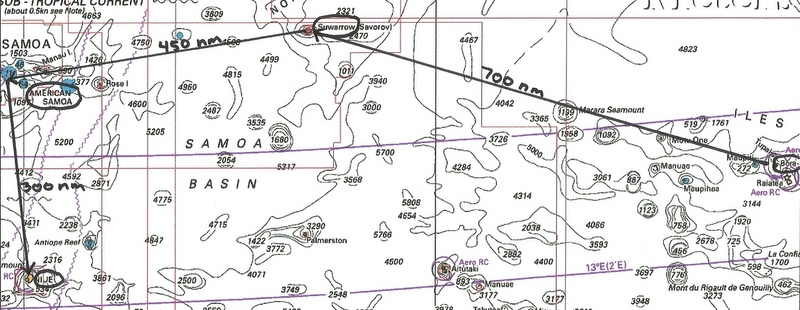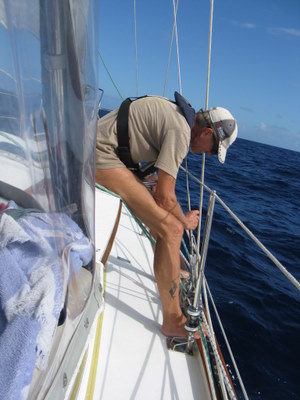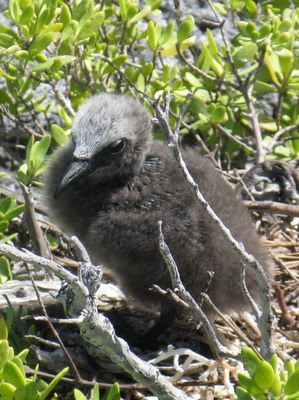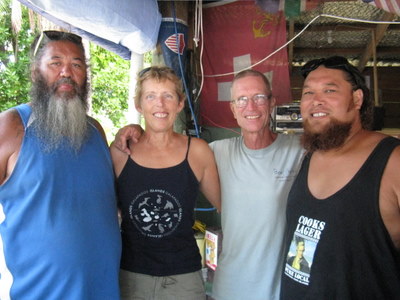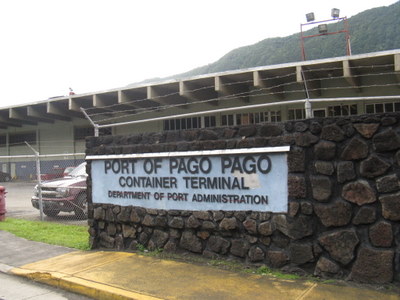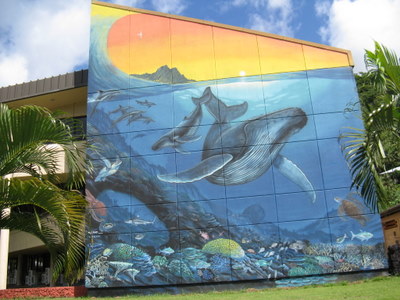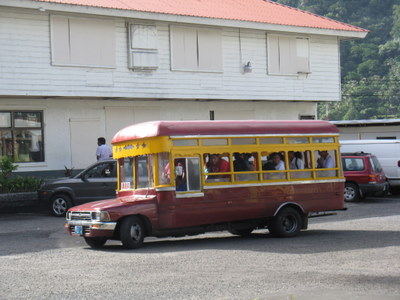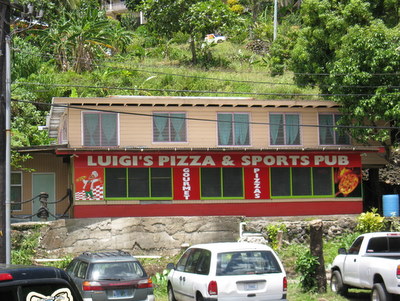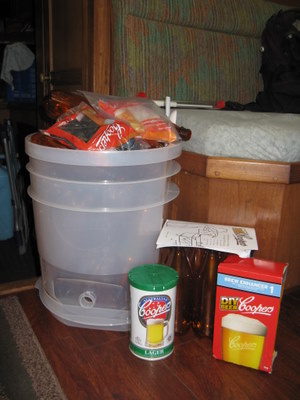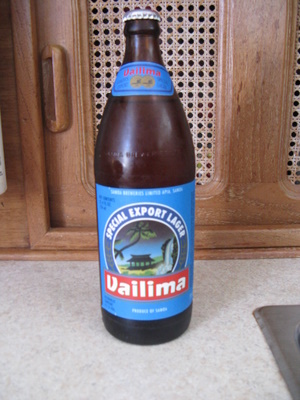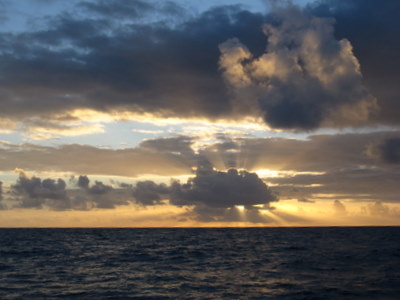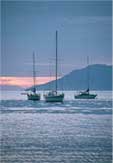
Current Location
(enter callsign KG6NNZ)
Logbook: Suwarrow Atoll, American Samoa and Niue - August & September, 2011
By the first of August, our six months in French Polynesia were up, and it was time to continue sailing west to visit some other places in the South Pacific. Our next couple of months took us over 1,400 nautical miles to three very diverse destinations - Suwarrow Atoll, which is an uninhabited island atoll and has been designated as a Cook Islands National Park; American Samoa, a territory of the USA with a tuna processing industry and one of the larger population centers in the South Pacific islands; and Niue, a small sparsely inhabited island nation with beautiful coastal landscapes.
|
|
Passage from Bora Bora to Suwarrow Atoll (August 2-8, 696 nm, 6 days). We left Bora Bora with a good weather forecast and expected to spend 5-7 days underway on our 700 mile passage to Suwarrow Atoll in the Northern Cook Islands. The first half of our passage was a little slow, but it went well, with winds mostly 10-15 knots from astern. We sailed wing-and-wing, with the mainsail out to port, and the headsail poled out on the starboard side.
Almost exactly half-way between Bora Bora and Suwarrow, we had a gear failure which had the potential of developing into one of our worst nightmares. But, our guardian angels were working apparently overtime. Although it was a scary situation, it could have been much worse. At 2 a.m. on August 5, we were changing watch, with Jan waking up and taking over, and Rich ready to lay down and get some sleep. During the past couple of hours, the winds had shifted to the north, so we needed to change our sail configuration - take down the pole and put both main and headsail on the port side. Winds were a little light, and every once in a while, the boat would shift and the sails would slat (or slam). That's not so unusual, but when we furled the headsail, the boat lurched, the sails slatted, and we heard a loud bang - what the heck was that?? It sounded like it came from below, and Jan descended into the salon and looked around but didn't see anything. We decided to go ahead with taking the pole down, and we turned on the deck lights. Rich clipped his harness to the jacklines running along our deck (standard operating procedure if going out on deck after dark), and he climbed out of the cockpit. As he moved forward to the front deck, he saw the problem, and his heart nearly stopped. The starboard lower aft shroud on our mainmast was hanging loose - the chainplate had broken.
For folks reading this who are not sailors, the masts on Slip Away (which is a ketch and has two masts) are held up by strong wires called shrouds and stays. We have six shrouds on our mainmast and four on our mizzen. The shrouds are attached to chainplates, which are secured to bulkheads built into the boat. If a shroud, stay or chainplate breaks, one risks having the mast fall down, and that would be a huge disaster.
Rich got the pole down as quickly as possible, and then he attached the spinnaker halyard to a padeye on the sailtrack for backup support on the side with the broken shroud. Next, he needed to secure the shroud, and he came back to the cockpit in search of some "Amsteel" line (rope which has the strength of steel). The line was buried deep in the cockpit locker, but at least we knew where it was! Life jackets, bundles of line and other assorted objects flew out of the locker and into the cockpit as Rich searched for the Amsteel line. He found it, went back out on deck, removed the broken part of the chainplate from the shroud and then also attached the shroud to the padeye on the sailtrack with the Amsteel line. The situation was under control, but we were both shaken.
| What to do? We were exactly half-way to Suwarrow Atoll - 350 miles into
a 700 mile passage. Suwarrow Atoll is about as remote a location as one
can get. It's an island in the middle of nowhere, a Cook Islands National
Park, with very little
connection to the outside world. No one lives there, except two rangers
who are stationed there for 6 months out of the year, and no ships call there.
We could turn around and sail back to French Polynesia and get repairs done at
the boatyard in Raiatea, but that would require sailing 350 miles to windward, which is hard on the
rigging (not to mention the
crew). Suwarrow Atoll was downwind so much easier to get to, and 450 miles further downwind was American Samoa.
We felt certain we could repair the boat in American Samoa, so we carried on.
The next morning, we checked in on the SSB Radio Net, and we advised our fellow boaters of our situation. Although we had things under control, we wanted them to know that we had a problem. We did not ask for help, but the cruising community immediately offered it. The two boats who were closest to our location were Endorphin, which was about 30 miles west of us, and This Side Up, which was about 10 miles north of us. Kathy on Endorphin volunteered to check in with us on the SSB Radio later in the day just to make sure we were doing OK. Mike on This Side Up altered course to get closer to us, and by that afternoon, he was within sight and VHF radio range. Mike (aka "Captain Thunderbunny") and his crew - Irene, Kendra and David - stood by and served as our escort for the remainder of the passage to Suwarrow. With our damaged rig, we reduced sail, which slowed us down, and the second half of the trip took a little longer than the first half. Also, the weather wasn't as good, which at times raised our anxiety levels quite a lot. The weather varied from spells of nice wind and slight seas, to squalls with rain and wind gusts in the high 20's, and a few hours of no wind at all, when we took down the sails and wallowed about in the ocean swell. Through it all, This Side Up stayed in close proximity to us, which wasn't always easy for them because she is a faster boat than Slip Away. On our last day at sea before arriving at Suwarrow, the fishing gods smiled upon us, and we caught a 44-inch mahi mahi, and we made plans to have the crew from This Side Up over for dinner when we arrived. |
|
We arrived at Suwarrow on the morning of August 8, six days after departing Bora Bora. Suwarrow is an atoll with only one navigable pass to enter the interior lagoon, but there were no strong currents in the pass, and we motored in easily. We breathed a huge sigh of relief when our anchor was set in the sand. The seas had been especially rolly the previous night, so no one got much sleep, and the crews of Slip Away and This Side Up were in desperate need of a nap. That evening, we hosted dinner for the crew of This Side Up on Slip Away, thanking them for standing by us in our time of need and celebrating a safe arrival in Suwarrow.
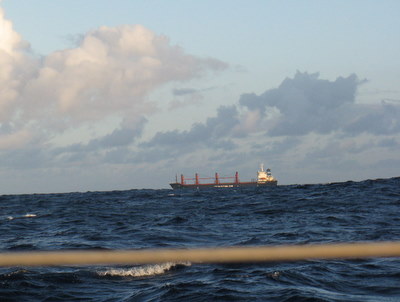 Amazing that we were in a remote corner of the Pacific Ocean, and this freighter passed within a couple miles of us |
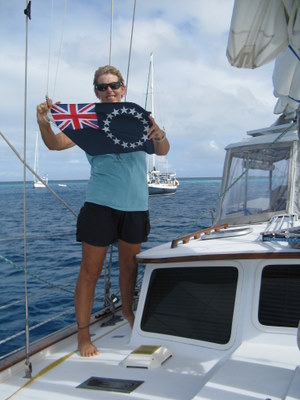 Jan hoists the Cook Islands courtesy flag. (The shroud from the broken chainplate is attached to the sailtrack padeye visible between her feet.) |
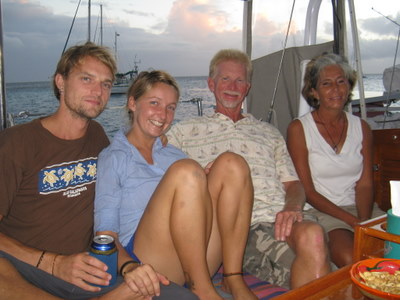 The Captain and Crew of This Side Up - David, Kendra, Captain Mike, and Irene |
| Suwarrow Atoll (August 8-16).
Suwarrow is an atoll in the northern group of Cook Islands, which is a
self-governing state with close ties to New Zealand. Suwarrow was discovered in 1814 by the Russian explorer Mikhail Lazarev,
and he named the atoll "Suvarov", which was his ship's name. It was called this for many years, until the Cook Islands
government changed it to Suwarrow.
The atoll has had few inhabitants - copra harvesters in the 1920's and 30's, New
Zealand Coast-Watchers during World War II, and a New Zealander named Tom Neale,
who lived here in the 1950's and 60's and wrote a book called An Island to Oneself
about his experiences. Today, the atoll is a Cook Islands National Park
and is uninhabited, except for a couple of park rangers who get assigned here
from June to November. No ships call here, so the only way to visit
Suwarrow Atoll is on a private yacht.
Suwarrow Atoll is a favorite stop for many cruising boats because the snorkeling, scuba diving, fishing and bird-watching are all outstanding here. There are a total of 25 motus (islets) inside and surrounding Suwarrow's lagoon, and some of them are nesting sites for sooty terns, boobies and other birds. The waters inside the lagoon and along its ocean shores host a wide variety of marine life - big stuff like sharks, manta rays and whales, but also beautiful coral reefs with smaller tropical fishes. The rangers are incredibly hospitable to their visitors and organize a number of activities from nature walks to snorkel excursions to pot luck dinners. This year's rangers' names were James and John. It was James' second season as a ranger at Suwarrow and John's first. Upon our arrival, James efficiently processed the paperwork required by the officials in Rarotonga (the capital) for our visit to the Cook Islands. Prior to coming to Suwarrow, we had met a few members of this year's fleet of cruising boats crossing the Pacific and heard some of their names on the radio, but we knew very few of them because we had been on a different schedule since we left Slip Away in Tahiti for the cyclone season. The bulk of this year's fleet got to Bora Bora about the same time we did, and now we were definitely caught up in the crowd. During our time in Suwarrow, there were about 25 cruising boats in the anchorage, which was a record number. We were envious of people we know who visited this atoll with just a few other boats. But, everyone was friendly, and it was nice to see a few folks we had met previously, and we made several new friends. The worst part of being in such a large crowd of new acquaintances was that our feeble brains had a difficult time remembering everyone's names! Ranger James, on the other hand, remembered every single person's name - he impressed us all! |
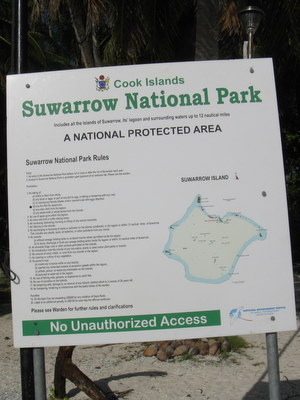 |
Shortly after our arrival, James organized a walk from Anchorage Island (by which we were all anchored) to Whale Island for some birdwatching. We, along with about 40 other people, walked across the sand and reef connecting the two islands at low tide, carefully stepping around live coral. We saw quite a few nesting terns and boobies, and birds were all around.
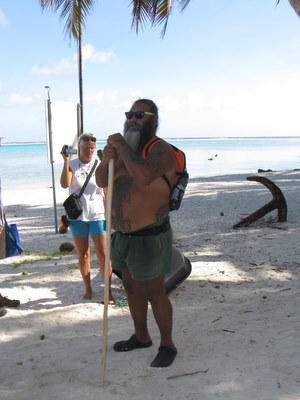 Ranger James leading the Nature Walk |
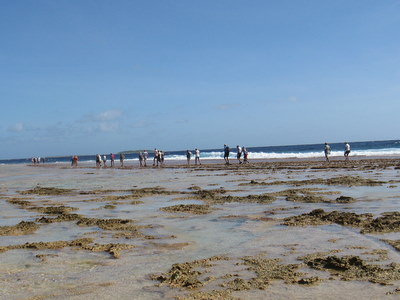 Walking to Whale Island at low tide |
|
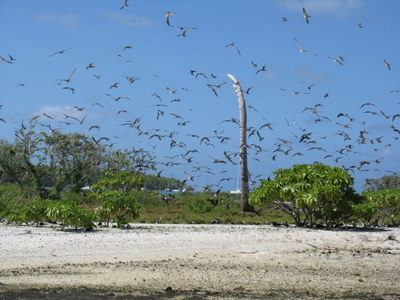 Bird watching on Whale Island |
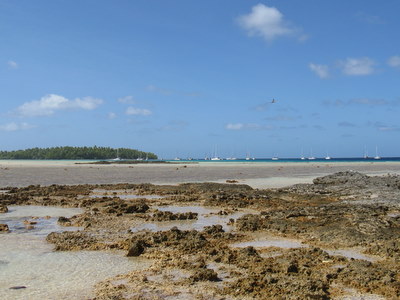 View of the anchorage from Whale Island |
Ranger John is a scuba diver, and on another day, the two of us, along with Glenn from Steel Sapphire joined him on a dive at Greenlands Benefit Reef, which was located just behind the anchorage. While donning our gear at the dive site, John, who was the first one in the water, spotted a huge manta ray swimming near us. Jan was also already in the water, so she saw him too, but by the time Rich got in, the manta was gone. However, shortly afterward, a group of three mantas swam by us. They didn't stay long, but we were all thrilled to see them. A couple of days later, we went back to this same dive site with a larger group - Glenn from Steel Sapphire, Gil from Endorphin, and Chris & Belinda from Nahanni. Shortly after we got into the water, all four manta rays came and spent the next 15 minutes playing and swimming around us. This was one of the most incredible scuba diving experiences we've ever had! Jan had the camera, and she snapped dozens and dozens of photos. That evening, she took our laptop to the potluck on shore, and most of the folks there spent some time looking at our pictures. Over the next couple of days, several people stopped by our boat with their flash drives, asking for copies of the photos, which we were happy to share. Before leaving, we also gave copies of all the photos on CD's to both James and John.
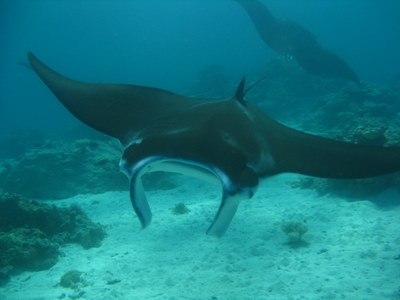 The manta rays weren't at all camera shy - they swam right up to Jan. |
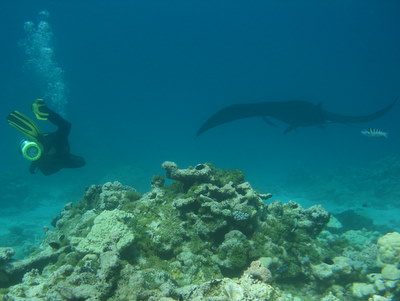 Rich swimming with the big one. His wing span was probably 8-10 feet. |
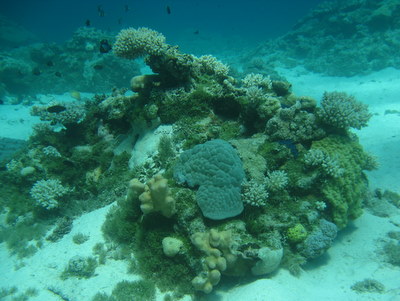 The coral reef at Suwarrow was healthy and colorful. |
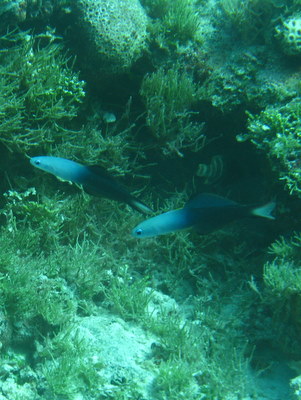 We saw a number of these two-tone dartfish. |
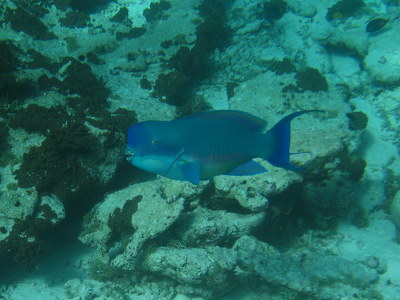 This Steephead Parrotfish posed nicely. |
Suwarrow is a special place - a bit of Paradise - and we loved it there. We spent our days snorkeling or scuba diving, chatting with James and John, visiting with fellow boaters, attending pot lucks or happy hours ashore in the evening, swimming in the lagoon and exploring the island. We were oblivious to the outside world, never really wanting to leave and only occasionally recalling that we had a broken boat. We were even starting to get the names straight of many of the new people we were meeting!
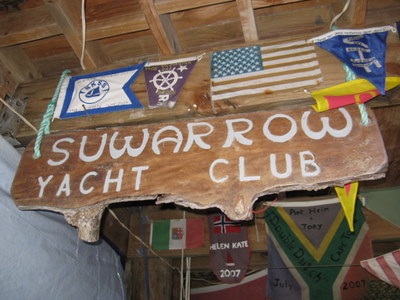 The Gathering Spot |
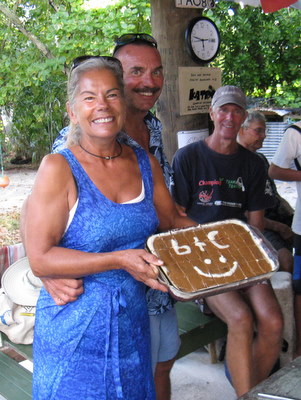 Belinda & Chris from Nahanni celebrate 30+ years of wedded bliss |
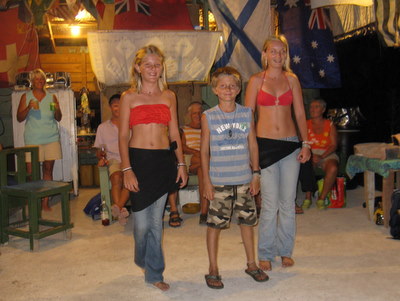 One evening, the girls from Gromit treated us to a performance of Polynesian dancing, which they learned while living in Huahine for the past year. Maia (left), Zoe (right) and their brother/sound engineer Liam. Proud Mom Cornelia clapping in the background. |
But, as often happens in this life, Mother Nature let us know that it was time to move on. We had been at Suwarrow a week when the weather forecast caught our attention. It called for another four or five days of good weather, but that would be followed by a weather system bringing very strong winds. If we didn't leave in the next day or two, it would likely be another couple of weeks before we found a suitable weather window for our passage to American Samoa. Although we wanted to stay in Suwarrow much, much longer, we knew we needed to go.
We also knew we needed to address our chainplate issue, and during our time at Suwarrow, we spent some time consulting with other cruisers about this situation. Replacing our chainplates had been at the top of our "To-Do" list for when we got to New Zealand later this year, but obviously this job should have been done sooner. Now we were worried that another chainplate could break. Another boat in the South Pacific - Brick House - broke a chainplate about a month earlier than us and was dismasted. We wanted to do everything we could to avoid that.
|
The cruising community proved to be a wealth of information and assistance to us. Our friend Mike from Infini spent some time on Slip Away brainstorming with Rich on ways to provide additional support for the rigging in case another chainplate were to break on the way to American Samoa. As a result of that discussion, Rich installed a couple of padeyes on the deck, and with halyards and other lines tied directly to the shrouds, he was able to provide backup support for all the shrouds on our mainmast. Glenn on Steel Sapphire suggested a better temporary repair for the broken chainplate. The total length of the chainplate was just over a foot, and about four inches of that broke off the top. By removing the lower part of the chainplate from the bulkhead and reinstalling it upside-down, we were able to re-attach the shroud to it (instead of the padeye on the sailtrack) and secure the chainplate to the bulkhead through two of the four original fastener holes, with an additional hole drilled and fastener installed between those two. Mike on Gromit had the necessary tools on board to drill through the stainless steel. Thank you to all! Boats came and went during our week in Suwarrow, and whenever one left, we could always hear sadness in the voices of the crew when they weighed anchor and said good-bye on the radio. Now, we knew exactly how they felt. In just over a week, Suwarrow entered our hearts, and James & John had become two good friends. We hung our Slip Away burgee at the yacht club so that future visitors would know that we had passed through. This was a very special stop - one we'll never forget. |
|
Suwarrow Atoll to Pago Pago, American Samoa (August 16-19, 455 nm, 3 days + 7½ hours). Quite a few of the sailing yachts in Suwarrow saw this weather window and also decided to depart. Nine of us - Infini, Songline, Mystic, Pua'Ena, Georgia J, Nahanni, Endorphin, Terra Nova and Slip Away - were all headed to American Samoa, and we set up a schedule to touch base twice a day on the SSB radio. In the afternoon of our second day underway when winds were light and the fleet was moving slow, Fred on Songline drew a line in the sand so to speak when he offered to buy coffee drinks for the boat landing the first fish. The challenge was on! It was a close competition between Mark on Pua'Ena, who landed a nice wahoo early the next morning, and Randy on Mystic who was declared the winner because he landed a mahi mahi about 10 minutes earlier. We caught four skip jacks during our passage - kept one and threw the rest back. There was also that big fish that got away - a strike that stripped most of the line off the reel before breaking the line and taking both lure and leader. Darn!!
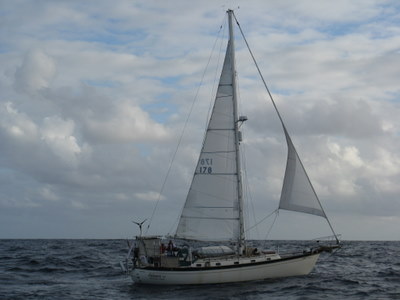 Nahanni underway to American Samoa |
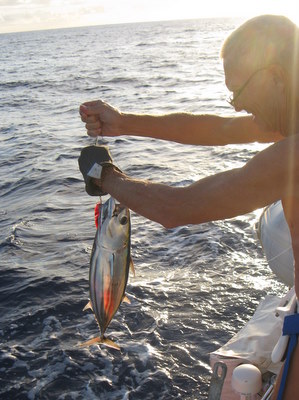 The small skipjack we caught didn't win us any prizes in the fishing tournament. |
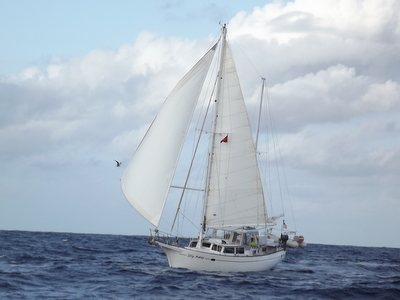 Slip Away sailing wing-and-wing underway to American Samoa (photo taken by Nahanni) |
We had good winds for the first day and a half that we were underway, but then the wind went light and we motored the last 41 hours. Some of our fellow sailors stuck it out and sailed through the lighter winds, arriving in Pago Pago a day or two later than us. But our goal was to get to our destination with no further equipment/rigging failures, so when the winds went light, we decided to minimize our time on the open ocean. We fired up the engine and picked up the pace, using Slip Away's horsepower to get us into port as quickly as possible (One of Rich's favorite quotes at a time like this is from the movie Risky Business, "Horsepower - there is NO substitute!"... It's a "guy" thing). When we were about three miles away from the entrance to Pago Pago harbor, we noticed a couple of whales spouting about a half mile from us - what a great sight!
| Samoa. There
are a total of 11 Samoan islands in the South Pacific which came from the same
roots and were once united. Colonialism in the late 1800's split
them apart, when the United States annexed the eastern islands of Samoa and the
western islands went to Germany. The Germans ran Western Samoa from 1900
to 1914, and then New Zealand took over (during World War I). Western Samoa
gained independence in 1962 and has been officially called "Samoa" since 1997. American Samoa. American Samoa is an "unincorporated" territory of the U.S. and shows no interest in changing that. American Samoa is comprised of seven islands, and the main harbor of Pago Pago, which is considered the best natural hurricane harbor in this part of the Pacific, is on the largest island of Tutuila. From 1900 to 1951, American Samoa was a U.S. Naval Base, and thousands of marines were trained on Tutuila during World War II. In the early 1960's, after Washington was criticized for neglecting American Samoa, President Kennedy authorized a huge infusion of federal funds, financing construction of roads, schools, housing, port facilities, electricity, hospital and other public works projects. Excessive government spending created an artificial American standard of living, and today Samoans depend heavily on American tax dollars to keep the party going. |
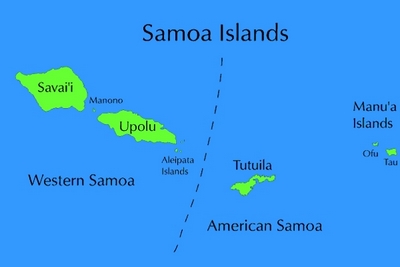 |
Pago Pago is a working harbor, with large fishing vessels coming and going on a regular basis. American Samoa's primary industry is tuna processing, which thrived as a result of favorable tax laws. For a number of years, there were three tuna plants operating here, and the harbor was horribly polluted. Only one tuna plant remains - Starkist - and the harbor is much cleaner than it once was. Pago Pago was the dirtiest harbor we've visited so far in the South Pacific, but it was no worse than some other U.S. mainland harbors. We did see turtles and other fishes in the harbor so it is not devoid of life, but there is plenty of room for improvement.

Pago Pago Harbor on the island of Tutuila, American
Samoa
Pago Pago, American Samoa (August 19 to September 24). We arrived Pago Pago on a Friday evening just around sunset. We found a good spot, dropped our anchor and slept soundly in a flat, calm anchorage. Pua'Ena arrived a few hours earlier than us on Friday, also having opted to motor and get into the harbor more quickly, but the rest of our small fleet trickled in on Saturday and Sunday. Since it was the weekend, the officials were not working and we couldn't do our check-in paperwork until Monday, but there appeared to be no proscription to our going ashore until then.
One of the first signs of American civilization that we noticed as we arrived in the harbor were the golden arches of McDonald's, right on the waterfront next to the dinghy dock. Rich was delighted - on Saturday we had lunch there, and on Sunday morning our friends Mike & Sue on Infini came along for breakfast. Two meals in two days at McDonald's was enough for Jan, but Rich frequently made a morning run ashore for a breakfast McMuffin. McDonald's was a big hang-out for the crews of the cruising boats because they offered free wifi internet every afternoon. We preferred to pay for wifi access from the anchorage so we didn't have to drag our laptop ashore, but we often stopped in at McDonald's in the afternoon to take a break from the heat, enjoy the air conditioning and an ice cream, and say hello to friends.
The weather was quite nice over the weekend, but we were watching the forecast and knew it wasn't going to last. On Sunday evening, the winds started to pick up, and by the middle of the night, they were howling - 25-30 knots. Although Pago Pago harbor is well protected from ocean swell, the wind still blows strong. The anchorage for the cruising boats is at the western end of the harbor, and since the winds were blowing from the east, this put the lee shore right behind us. The worst part of this anchorage, however, is the holding. The bottom of this harbor is littered with debris, much of it the result of a tsunami which occurred in 2009 and washed tons of junk into it. Many boats' anchors hooked onto debris, instead of digging into mud or sand, and the debris would sometimes shift and release the anchor causing the boat to start dragging toward another boat or the shore. When this weather hit Pago Pago, there were about 25 cruising boats anchored in the bay, and several of their anchors started to drag. At times it was mayhem, but this group of sailors kept their cool, dealt with the situation and helped each other out whenever they could. At one point, This Side Up started to drag, and when Mike started his engine to move forward to re-set his anchor, his prop got tangled in a line from an old mooring, and he was unable to move his boat. Boats anchored close to him saw his predicament and immediately came to his aid. They could not move the boat forward, but they set a couple of additional anchors to keep him from drifting further backward, and he stayed put, precariously close to the lee shore. The seas were too rough at this point to dive on his prop and untangle or cut away the mooring line, and the line was securely attached to the bottom. At another point, a smaller sailboat started to drag, and Fred from Songline, Randy from Mystic and Chris from Nahanni used Nahanni's dinghy to move it to a dock. The dragging of this smaller sailboat had disturbed the anchors of Songline, Mystic and Nahanni, and then it appeared that those three boats were starting to drag. Since the guys were helping to move the other boat to the dock, the girls were on board by themselves. These ladies are all quite competent sailors, and though we could hear their nervousness in their voices on the radio, they kept their cool, started their engines and prepared to deploy extra anchors. At this point, Rich launched Slip Away's dinghy and went to see what help he could provide, but they had everything under control.
Most of the boats in the harbor had arrived in Pago Pago over the weekend, and we were supposed to do our official check-in paperwork on Monday, but the Harbormaster came on the radio to tell us to stay on our boats and do it on Tuesday. The Harbormaster piloted a big ship into the harbor on Monday during some of the worst weather - no small feat - and he knew how rough it was out on the water. On Tuesday, boats took turns going ashore for the official check-in paperwork. We were anchored near Georgia J, and Kim & Sharon watched over Slip Away while we went ashore to check in. When Kim & Sharon went ashore to check in, Rich sat on Georgia J, while Jan kept tabs on Slip Away.
|
|
|
The strong winds continued for several days. After Monday, the anchor-dragging incidents settled down a bit, but they were by no means over. The worst part of all this was that the dragging incidents were random occurrences. Often times a boat's anchor would hold securely for several days, but then start dragging for no apparent reason. Pua'Ena stayed put through the worst of the high winds, but a few days later in the middle of the night, with only 15 knots of wind, it started dragging. Everyone was on edge, and for the next several days, no one left their boat unattended. Most crews ran anchor watches around the clock - taking turns sleeping at night. We ran our anchor alarm 24/7 on our chartplotter, so that if we started to drag, the alarm would sound. Rich had a hard time sleeping at night when the winds were blowing hard, so he dozed most nights on the settee - closer to the chartplotter so he could hear if the anchor alarm sounded. Knowing that Rich was on high alert, Jan was able to get some sleep. She would go to bed early and get up early, and once she was up in the morning, Rich would lay down and sleep for a few more hours. By mid-week, there were some settled moments, and Mike on This Side Up was able to free his prop from the mooring. He re-anchored, and a couple other boats also relocated. At this point, a few boats discovered a new problem - they were unable to get their anchors up because either their anchor was caught on debris or their chain was wrapped around it. Fellow boaters with scuba tanks on board provided help to those who needed it. There were a couple of guys in the anchorage who were retired from professional diving careers - Bill on Dilligaf was a salvage diver, and Andy on Savannah was a Navy diver - and they were in high demand.
Once the weather settled down, we needed to get to work on replacing our chainplates. Prior to our arrival in American Samoa, we had contacted David Robinson, a British ex-pat who lives here and volunteers as a cruising station host for the Seven Seas Cruising Association (SSCA), of which we are members. David has lived in American Samoa for several years, and although he is "retired", he keeps incredibly busy. He is friends with the Governor of American Samoa, sits on several committees for him, and also serves as the co-CEO of the local shipyard. We emailed David from Suwarrow and asked if he could help us get new chainplates made, and prior to our arrival, he made some contacts on our behalf. By the middle of our first week in American Samoa, David had introduced Rich to Andy Wearing, a New Zealander who is the Manager of Industrial Gases, a gas (oxygen, acetylene, etc.), welding and fabrication business. Andy had a sheet of 316 stainless steel that was perfect for our application. Rich provided measurements, and Andy cut and drilled the steel to our specifications. The project was completed in about two weeks time, and Andy did the work for a price that was unbelievably cheap.
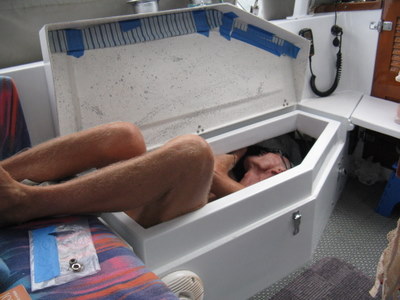 Rich installing one of the new chainplates - fortunately, he's lean and flexible and can get at some of those hard-to-reach places! |
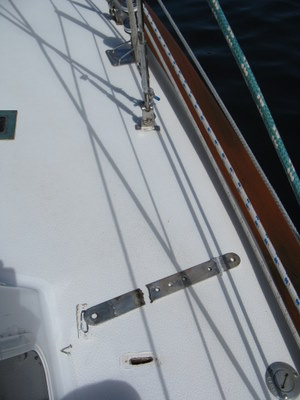 The broken chainplate and the point at which it goes through the deck. Above it (forward on the deck), a non-broken shroud/chainplate attachment is visible. |
 Rich with Andy of Industrial Gases (left), and Peter of The Tool Shop Store |
Although American Samoa was not on our original itinerary, a stop here was very worthwhile, and it was such a bonus to be in an English-speaking country. After bumbling through Spanish- and French-speaking countries for the past eight years, this was great! We could finally walk around town without an electronic dictionary in our pocket, and we could talk with vendors about our boat repairs in a language that all of us understood. Most of the local people speak both Samoan and English, and they seemed to appreciate it when we tried to say hello ("talofa") and thank you ("fa'afetai") in Samoan.
Grocery shopping in American Samoa is some of the best in the South Pacific, with a good selection of items and most of them reasonably priced. We were thrilled to find fresh celery, broccoli, cauliflower and sometimes romaine lettuce - all imported but good quality and affordable. Unfortunately, there wasn't much locally grown produce - bananas, taro and coconuts were the primary offerings at the local market, and a tasty tomato was virtually impossible to find. There is good local bus service that takes riders almost anywhere on the island, usually for $1 each way. We didn't eat out a lot, but we sampled a few local restaurants - Jan's favorite was Luigi's Pizza, which served authentic New York style pizza by the slice - we ate several lunches there. Additionally, we took advantage of the local healthcare system (subsidized by American tax dollars) and got our teeth cleaned by a very competent Samoan dental hygienist who trained and previously lived in Washington State.
|
|
|
Access to the U.S. Postal service was also a nice benefit of a visit to an American territory. Shipping items to American Samoa via the USPS costs a fraction of what it costs to ship items overseas by UPS, Fedex or DHL. After installing our chainplates, we were having an issue with our generator. Rich called Northern Lights technical support (via Skype), which helped him troubleshoot the problem. We then ordered parts and had them shipped to us via Express Mail, and they arrived a few days later. Also, Rich had recently met another boat which was brewing their own beer onboard using a Cooper's Beer Kit, which was available through Amazon.com. Amazon would not ship the beer kit to American Samoa, so we shipped it to Jan's sister Judy, who sent it on to us. The downside to using the USPS is that they aren't always reliable. We had a total of seven packages shipped to us via Priority or Express Mail, and six of them arrived with no problem. Unfortunately, they lost the package containing additional beer mixes for our Cooper's kit. The tracking number showed that it arrived in American Samoa and was "delivered," but the local post office was never able to determine to whom it was delivered. Fortunately, we did receive the beer making kit, and it came with one beer mix, so we weren't totally SOL.
On the subject of beer, the two of us were in agreement that American Samoa's "Vailima Special Export" was one of the best local beers we've ever come across. It's actually brewed in Western Samoa, but the Vailima sold in Western Samoa is 4.9% alcohol, and the "export" sold in American Samoa is 6.7% alcohol. We loved the taste, but we actually would have preferred the lower alcohol content. The beer comes in 750 ml bottles, and we usually shared a bottle because a whole beer gave us quite a buzz! Apparently, we're not the only ones who think this is a good beer because several times it won the "Grand Gold Medal" at the Le Monde Selection in Brussels, Belgium.
|
|
|
Before visiting a new destination, we do some research on the location to get a general idea as to what we can expect. In addition to reading travel books such as Lonely Planet or Moon Handbooks, there's a wealth of information available from other cruising yachts who have gone before us. However, we try not to prejudge a place based on what we've heard because a variety of factors can affect individuals' experiences and/or perspectives. We'd heard mixed reviews on American Samoa - some people loved it and others hated it - so we were curious to see what we would think about it.
One of the things we heard prior to arriving in American Samoa was that it was dirty and strewn with trash. There's no doubt that the people of American Samoa need to work on cleaning up their litter, but we thought it wasn't nearly as bad as Central America. We were quite happy to learn that non-biodegradable plastic grocery bags - the bane of the ocean and all waterways - have been outlawed in American Samoa. The local businesses use bio-degradable plastic grocery bags, but they prefer if you bring your own bags - very progressive!
We also heard that the Samoans are fat and lazy. Unfortunately, American influence in these areas has not been positive. Samoans' previous diet of fresh fish and locally grown fruits and vegetables has been replaced with prepared foods and fast food. McDonald's, Pizza Hut, KFC and Carl's Jr. all have restaurants here. The Samoan race is very large in stature, and there are a lot of overweight Samoans, but the percentage is probably no more than that of overweight Americans in general. Also, from what we saw and heard while we were here, we would agree that most Samoans don't work very hard. Their old culture was one of subsistence living - they fished and tended their crops and lived in a tribal community. Missionaries and colonial powers, especially the U.S. when it took over American Samoa, encouraged the local people to abandon their old ways. Maybe this is a culture that isn't cut out for a capitalistic society, or maybe there's just no motivation for them to work hard. The U.S. created numerous federal jobs in American Samoa - obviously way more jobs than are necessary because most of those government employees aren't very busy. The U.S. also sends a lot of welfare and food stamps their way.
That said, Samoans are very patriotic people, and a high percentage of their young people join the military. High schoolers who are joining the armed forces would occasionally wear their military uniforms to school, and we were amazed to see how many there were. Another career path that seems to offer some opportunity for Samoans is professional football. There are a couple of Samoans presently playing for the Cincinnati Bengals, and when the locals learned that Jan's family lives in Cincinnati, they very proudly told her that they knew someone who played for the Bengals - it was either their cousin or friend or sister's boyfriends' brother or some other acquaintance.
Overall, we found the Samoan people to be incredibly friendly - some of the friendliest we've encountered in all of our travels. We enjoyed our conversations with the local people - from the guard at the dinghy dock to fellow bus riders or the officials we dealt with. They were very kind and helpful. If we needed assistance with directions, we never hesitated to ask someone on the street. American Samoa gets very few tourists, and they were very warm and welcoming to those of us who arrive on cruising yachts. We were also quite impressed with how smartly dressed the locals were. The women often wear two-piece dresses - a long skirt with a tunic top - very stylish. Men have an interesting dress code - instead of pants, they wear skirts called lava lavas. We wished we had our camera when we saw a ranger from the National Park Service dressed in his uniform, which looked exactly like a uniform one would see on the mainland U.S., except that he wore a perfectly coordinated lava lava instead of pants. Uniforms for the school kids were unisex - both the boys and girls wore skirts. Skirts are much cooler than pants in the tropics.
We ended up spending a month in American Samoa, and although we spent most of our time here working on boat repairs, we did find a few opportunities to get away from the main harbor and see other parts of the island. The island of Tutuila is mountainous and very green and lush - not surprising since they get an average annual rainfall of 131 inches (3326 mm). This island is every bit as beautiful as the Society Islands of French Polynesia, and much of it is designated as a National Park. Our friends Kim & Sharon on Georgia J had some work done by a local mechanic named David, and on a Saturday, he took the four of us on a driving tour of the island, so we had the opportunity to see most of this island's beautiful landscape. Unfortunately, we also got to see first-hand some of the destruction from a tsunami which hit here in September of 2009. The tsunami resulted from a large earthquake centered off Tonga and was one of the worst natural disasters to ever hit this island. Because they were so close to the earthquake epicenter, they had little to no warning of the tsunami, which hit early in the morning. Thirty-four people were killed, including one American from a cruising sailboat, who drowned when he was washed off the dock trying to untie his lines. Numerous houses were washed away, and although a good majority have been rebuilt with FEMA funds, there are still a few folks living in tents.
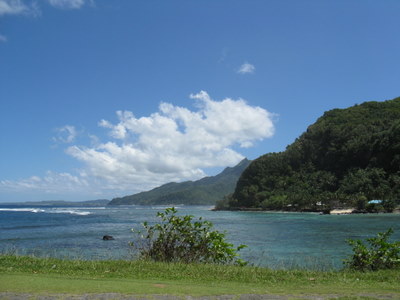 Some of American Samoa's beautiful coastline |
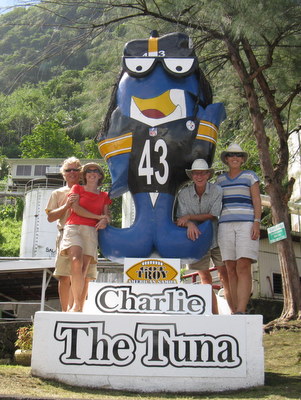 The two of us with Kim & Sharon from Georgia J - we couldn't resist a picture here! |
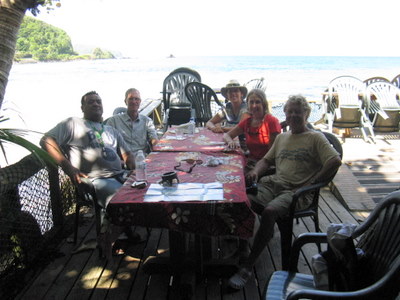 Lunch at Tisa's Barefoot Bar |
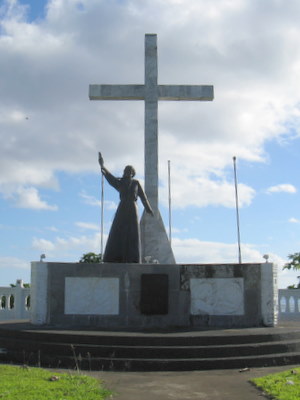 Monument to John Williams, the first missionary to arrive here in 1832. When the tsunami struck, this monument was not damaged, but everything around it was destroyed |
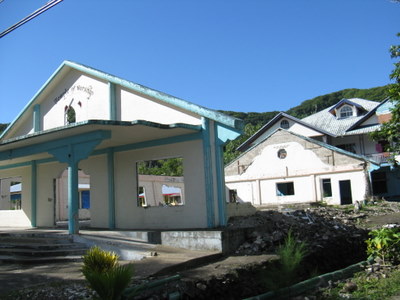 Tsunami damage in the village of Leone |
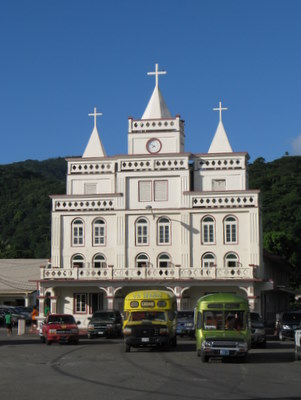 Missionaries were very successful in converting Samoans to Christianity. There is an incredible number of very large churches on the island. |
In addition to the driving tour, we did some hiking. At the local National Park Services Office, we picked up a brochure which mapped out a number of hiking trails on the island. Jan joined some of the other cruising ladies for a "girls only" hike one day - a beautiful trek to Mt. Alava which overlooked Pago Pago Harbor, and then down the north side of the mountain to Vatia Bay. It was quite a workout, but it was a great hike and a couple of weeks later, the two of us and Chris & Belinda from Nahanni hiked back up to Mt. Alava to enjoy the views.
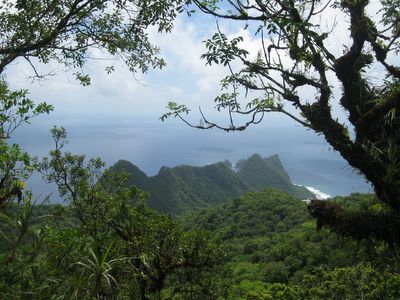 View of Pola Island on the north side of Tutuila |
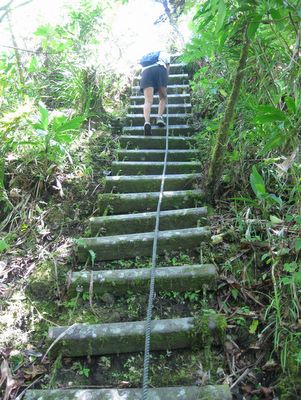 The National Park Service maintains the hiking trails. These steps on the steep parts of the trail were much appreciated! |
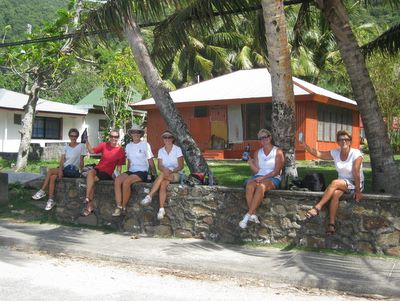 The girls enjoying a cold beer after their hike and while waiting for the bus in Vatia |
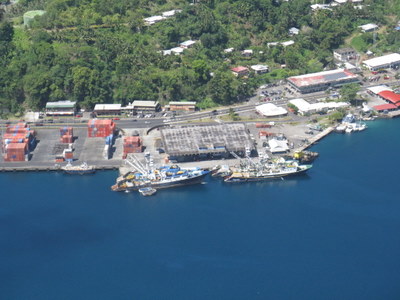 View from Mt. Alava - the customs dock with a couple of large fishing boats awaiting clearance. |
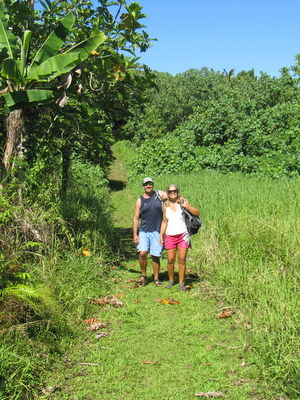 Chris & Belinda from Nahanni on our hike to Mt. Alava |
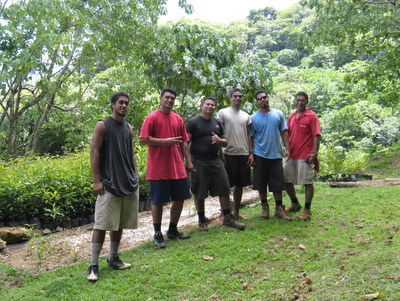 On our hike, we ran into these park service rangers who were clearing out some invasive species / non-indigenous plants growing on the island. |
After a month here, it was time to go. Most of the folks with whom we arrived had already moved on, and there were only a few boats left in the harbor. Slip Away was for the most part in good working order, and we were eager to be on our way. We enjoyed our time in American Samoa, but there were a few things we would not miss. Although we were anchored in a good spot in terms of holding (we were one of a few boats that never dragged), we were right in front of one of the local power plants, with the sound of generators running 24 hours a day. The other thing we would not miss was the smell of the tuna processing plant. It wasn't constant, but at least once a day, the factory would open its vents and spill out a nasty smell that permeated the harbor for about 10 minutes. Rich was bothered more by the generators, but Jan detested the stink from the tuna plant.
The day before our departure, we needed to visit several officials' offices (Harbormaster, Immigration, Customs, etc.) to do our departure paperwork. As luck would have it, we woke up that morning to find a cruise ship in port - the only one to visit this island during our entire month here. We were concerned that this would cause long delays in our paperwork processing, but fortunately, the effect was minimal. The Harbormaster was initially tied up on the cruise ship, but by the time we were done with Harbor Administration and Customs, he was available. Captain Silila Patane is the Harbormaster and Ship Pilot in American Samoa and one of the few American Samoa officials who works hard at his job (at least from our viewpoint). He is a very warm and friendly man, and both times when we visited his office (arrival and departure), he took time to chat with us. He is retired from the U.S. Army and had great stories to tell us about some of his experiences. He also presently has two sons serving in the armed forces, and he is very proud of them. Officials in the other offices were also very friendly and pleasant, but they had some pretty cushy jobs. It wasn't unusual to find them reading the paper, playing computer games or taking a nap. Your tax dollars at work!
After completing our departure paperwork, we met David Robinson for lunch. He had become a good friend over the past month and helped us out with much more than our chainplates. A couple weeks earlier, to thank him for his help, we gave him a book, The Path Between the Seas by David McCullough (the story of the building of the Panama Canal). At lunch that day, he surprised us with a copy of a recently published book, Samoa, written and autographed by J. Robert Shaffer. It is an historical fiction novel recounting the discovery, settlement and development of the islands of Samoa. It's an outstanding read and a gift we truly cherish.
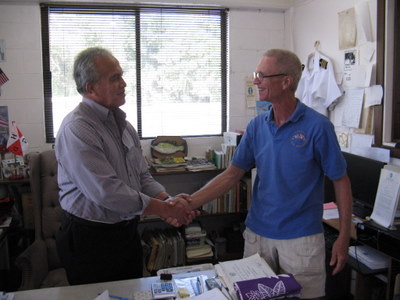 Rich with Captain Silila Patane, American Samoa's Harbormaster |
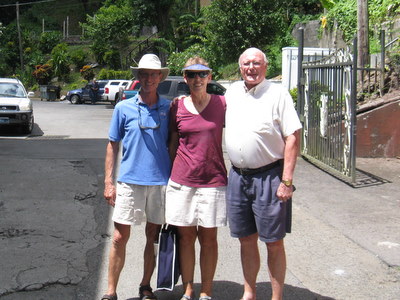 The two of us with SSCA Cruising Station Host David Robinson |
Weighing anchor the next day took some time. There was a lot of growth on our anchor chain and Rich had to scrub it foot-by-foot as we brought it aboard, but fortunately, the anchor and chain were not hung up on any debris and came up with no problem. We were on our way.
| Passage from American Samoa to
Niue (September 24-27, 310 nm, 2 days & 21 hours). Before our
chainplate breakage, we had
intended to visit the island of Niue after Suwarrow Atoll, but when we had to change plans
and go to American Samoa, we expected
we would have to forego this stop. Niue sits almost directly south of
American Samoa, and at this time of year, the tradewinds generally blow from the
southeast. With a west-setting current in the South Pacific, we would have
expected a passage from American Samoa to Niue to be 300 miles upwind, which did
not interest us. However, the weather forecast for the next couple of days
called for light northeast winds, turning to east winds, so we decided to give
it a try. Worst case, if we couldn't make it to Niue, we could turn west
and head for Tonga.
Ironically, this ended up being the most enjoyable multi-day passage we've ever had. Winds were fairly light, but we were able to sail the entire distance. We kept the wind 60 degrees off our bow and made some easting in the northeast winds, so that we could still lay Niue when the winds turned east. The wind blew mostly 8-12 knots and seas were calm. We had no squalls, and the wind never got up over 15 knots. We didn't set any speed records (our average speed was 4.5 knots), but slow and calm is way more pleasant than fast and rough. Our only complaint was that we sailed during a new moon, so nights were dark, but the stars were beautiful. |
|
We arrived at Niue late morning on a Tuesday, and when we got within VHF range, we called "Niue Radio" to notify them of our impending arrival. They instructed us to take a mooring, and call them back when we had our dinghy in the water and were ready to come ashore. We did so, and the Customs and Quarantine officials met us at the wharf to process our paperwork. After we were done with the officials, we were welcomed by Keith Vial, who is the Commodore of the Niue Yacht Club and also an SSCA Cruising Station Host. Keith took us in his car for a quick tour of the town of Alofi, and then dropped us off at the local police station to complete our check-in with the Immigration officer.
| Niue (September 27
to October 2). Niue
(pronounced new-WAY) is a 164-square mile (264 square kilometer) singular island
in the middle of the South Pacific. It's one of the world's largest
uplifted coral islands and is known as "the rock." It is also one of the
world's smallest self-governing states, but it operates in "free association"
with New Zealand , meaning that it uses New Zealand currency, their citizens enjoy dual
citizenship and aid from New Zealand funds the vast majority of their local
government's operating budget.
Visiting this island by private yacht presents a few challenges, but the Niueans do their best to make it accessible. The anchorage at Niue is deep and rocky, so the Niue Yacht Club maintains mooring balls in the harbor, which we felt was a better option than trying to use our own anchor. (Using a mooring ball is not the best option if they are not properly maintained, but we were assured that these were.) The moorings are located off the town of Alofi on the west side of the island, so the area is protected from the prevailing winds, but it is an open roadstead, so there's no protection from ocean swell. The dinghy landing here was the most unique and challenging one we've ever experienced. We pulled the dinghy up to a large concrete wharf and used an electric crane to lift the dinghy out of the water and on to the wharf. For us, the process involved Rich driving the dinghy up to the wharf, Jan scrambling out of the dinghy and up a ladder on to the wharf, then Rich attaching the crane hook to a lifting bridle on our dinghy (which he made with rope). After attaching the crane hook, Rich climbed out of the dinghy on to some nearby steps, and Jan pushed the "up" button on the crane to lift the dinghy, while Rich guided it on to the wharf. This operation was sometimes a bit exciting depending on the amount of ocean swell that was running, and it required some dexterity, which is not Jan's strong suit! But, we managed it all with no major foul-ups, and our dinghy wheels were very helpful for moving the dinghy into its parking spot on the wharf. |
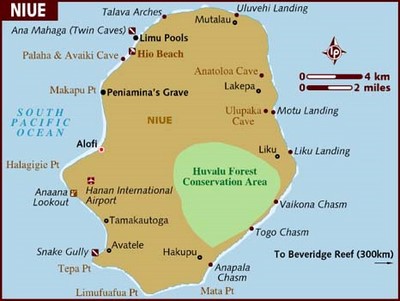 |
Niue is a humpback whale preserve - every year during the Southern Hemisphere winter (approximately May to November) humpback whales migrate from the colder southern ocean to the warmer waters around Niue to have their babies. We have several friends who had had whales swim close by their boats in the Niue anchorage, and some friends even swam with the whales here. We were hoping for a whale encounter, but when we arrived in late September, they were no longer around. On the wharf, we met a young marine biologist who was there to study the whales, and she told us that the whales peaked early this year - in August. In the past week or so, they had seen only one cow and calf in the area, and they hadn't seen them in the past couple of days. Drat!
The day after we arrived in Niue, the winds completely died, and a southwest ocean swell developed, which made the anchorage very rolly and uncomfortable. We knew we wouldn't get much sleep in these conditions, so we looked into staying ashore for a couple of nights. Accommodations at the Kololi guesthouse were reasonably priced, so we booked a room and left Slip Away secured to a mooring ball. We thought we would sleep better at the guesthouse, but our first night there, a barking dog and crowing roosters kept us awake. Jan was prepared with earplugs the next night. And, we didn't totally abandon Slip Away. We braved the challenge of the dinghy dock each day to check and make sure her batteries were sufficiently charged, and while doing that, we usually packed a lunch for our day's excursion.
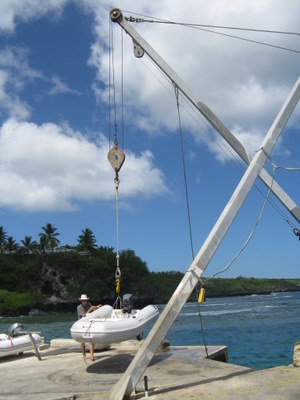 Lifting our dinghy onto the wharf with a crane |
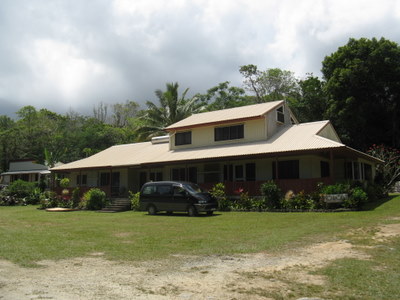 The Kololi Guesthouse, where we spent a couple of nights |
The waters around Niue are incredibly clear, and we considered doing some scuba diving here, but much of the coral on the west side of the island was killed off by a devastating hurricane in 2004. In addition to whales, the big attraction when diving at Niue is sea snakes. Sea snake bites are deadly, but from what we understand, their mouths are so small that it's almost impossible for them to bite a human. Although we've gotten quite used to snorkeling and diving with sharks, we didn't particularly relish the idea of diving with snakes, so we passed on that.
Although we spent little time in the water here, there was lots to explore along Niue's coastline. Millions of years ago, when this island was being formed and pushed up from the sea, beautiful chasms, caves and crevices were created on the shoreline. To get to these sights we needed some transportation, so we rented a car for a day and drove around the island, stopping along the way to visit the Anapala, Togo and Matapa Chasms, as well as the Talava Arches. The trailheads to the sights were well marked, the treks along the pathways were fairly easy, and the limestone formations were gorgeous! Another day, we rented bicycles and pedaled up to the Limu pools, where we did some snorkeling and swimming.
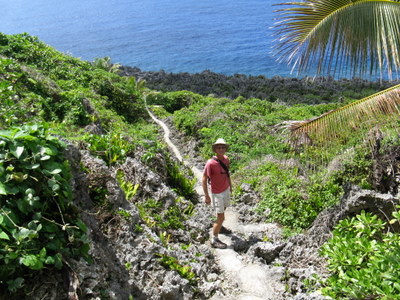 Rich hiking the trail to the Togo Chasm. |
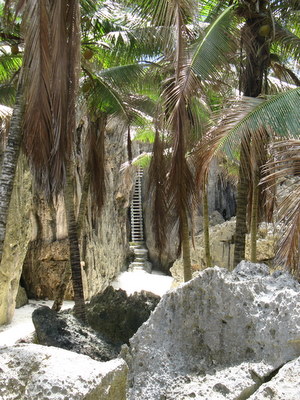 A steep ladder drops into the Togo Chasm, which is filled with white sand and palm trees. |
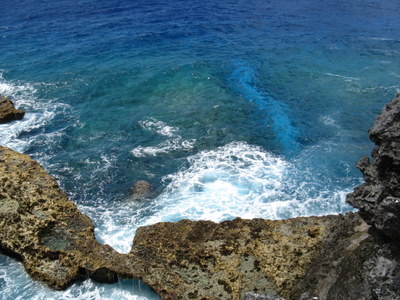 The beautiful clear blue waters along Niue's shoreline |
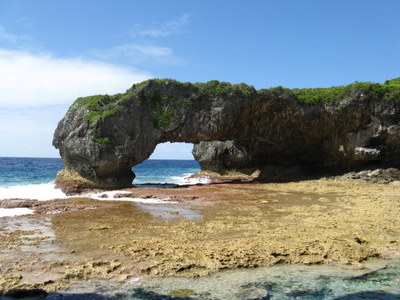 Talava Arches |
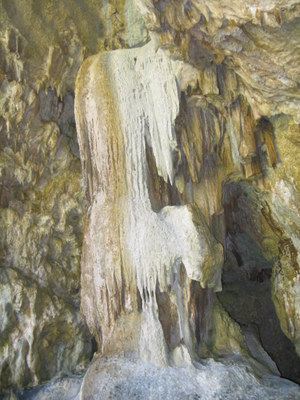 Beautiful and colorful limestone formations in the cave at Talava Arches |
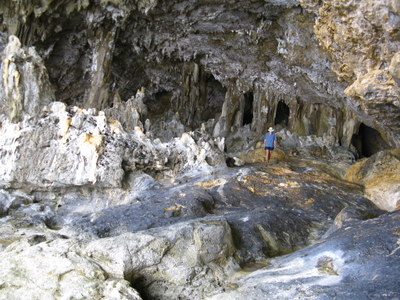 Jan exploring Palaha Cave |
Most afternoons we stopped in at the Niue Yacht Club. There were a few other cruising boats at Niue, and we sometimes met their crews at the Yacht Club and shared a beer. We especially enjoyed the hours we spent talking with Ira, a New Zealander who, along with her husband Brian, now lives in Niue and manages the Yacht Club and the Niue Backpackers guesthouse, which share the same location.
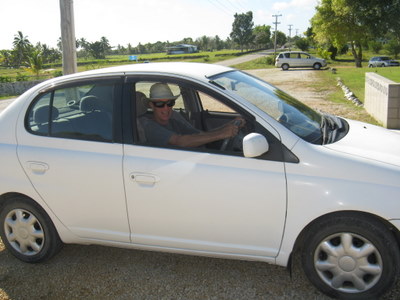 This was Rich's first opportunity to drive on the left side of the road - but he did fine! |
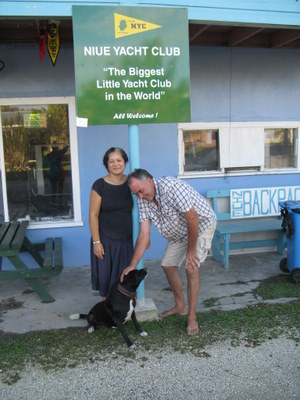 Ira, husband Brian and puppy Lucy at the Niue Yacht Club |
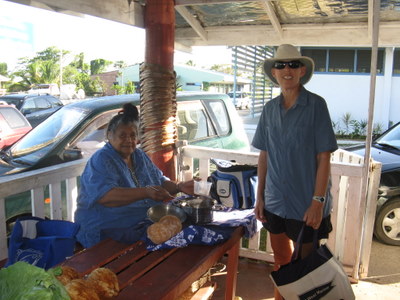 Jan tried the breakfast porridge at the local market - it was a bit ... pasty. |
On our last day in Niue, we decided to do a snorkel around the anchorage. The water was so clear and inviting that even though we didn't expect to see much coral or fish life, we at least wanted to put our faces in and take a look. As expected, much of the coral was dead, but the rock formations along the coast were beautiful, and we saw a reasonable amount of fish life. We also saw a few sea snakes - they swim between the bottom and the surface on a regular basis. We'd heard that the sea snakes are often curious and come to check out snorkelers or divers, but thankfully they were not interested in us!
We enjoyed Niue - the people were friendly, and the island terrain was beautiful and quite different from other places we had previously visited. But, we wonder about the future of this small island because there's not much driving its economy. There is some tourism here, but there's only one commercial airline flight in and out of Niue each week, and only a few thousand people visit the island each year. We were told there is also some agriculture industry on Niue, but it's minimal. Jobs are limited and the cost of living is high. Groceries here were very expensive - some of the highest prices we've seen in the South Pacific. The great majority of Niuean's have left the island and moved to New Zealand in search of better opportunities. There are less than 1,500 residents left on the island, and about 20,000 Niueans live in New Zealand. We've never before seen so many abandoned houses, many of them with graves of deceased family members in the side yards.
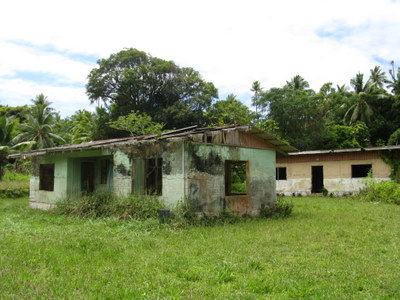 Most of the houses that we saw on Niue were abandoned. |
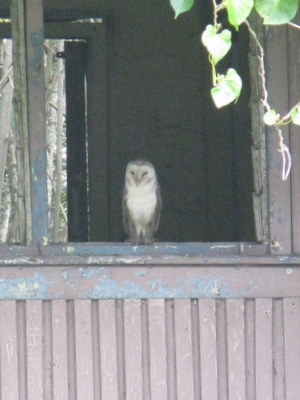 An owl had taken up residence in this abandoned house. |
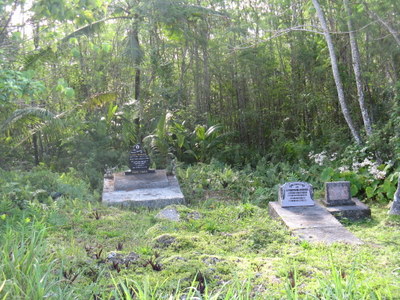 Many of the abandoned houses had graves in the yards, and some of the graves like these were located randomly along the side of the road - most likely on family property. |
After five days in Niue, we were ready to move on, and the weather was right. We did our check-out paperwork with the Customs & Immigration officials, paid our bill at the Niue Yacht Club and bid good-bye to Ira there. We untied Slip Away from her mooring and headed west for Tonga.
